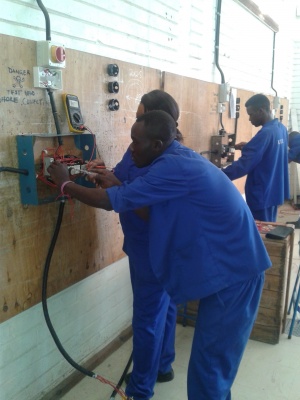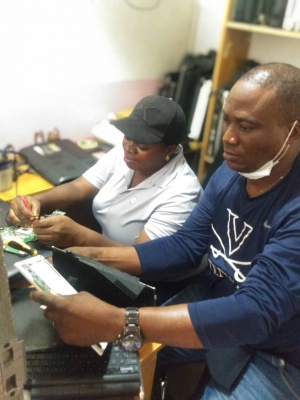CTVSD2/Design/Step2
Choose your assessment methods
Start with reviewing the OARAS assessment section and the ideas you have drafted there with the profile of a competent person in mind. Knowing what knowledge and skills are required for learners to demonstrate, you are in a position to determine which methods are best suited to gather that evidence. Idelay you will do that in collaboration with learners as well as colleagues, trainers/ assessors and industry or employer representatives. Once you have done that you may need to update the OARAS assessment section as it is likely that the assessment ideas you have drafted may have changed or have been developed and refined further.
When choosing assessment methods keep real work scenarios in mind. Talk to the master crafts people and industry practitioners what is actually happening at the workplace. Real work does not usually fall into categories that reflect individual standards of competency. In general, a work activity incorporates a number of standards of competency at the same time. A good assessment task may involve clustering a number of competencies or performance criteria together to reflect a real work task or particular job. How many outcomes can be clustered together and integrated in one assessment to reflect a real work activity will vary depending on the training programme and context.
Choose an approach
There are four approaches you can consider when designing assessments:
- Consider individual assessments for each element and performance criterion and then identifying what might be common in terms of assessment activities.
- Group assessment around context of performance (i.e. case situations, particular service delivery or client groups).
- Group inputs to be assessed by skill or knowledge base.
- Group outcomes or the ways in which various elements link up into a complete process or product.
Picking one approach independently is unlikely to provide effective assessment of all competencies in a course or module. An integrated assessment approach could be a better option. It can enable effective assessment of a range of elements and performance criteria clustered together, rather than collecting evidence for each element and performance criterion separately. Check out the resource on integrated assessment in the learning resources section of the course to find out if that is the appropriate approach for you and how to go about it.
When selecting a method of assessment and whether to integrate or cluster outcomes together you need to have a clear understanding of the industry and the practices of a typical workplace. Ideally you should visit the workplace and work with a master craftsperson to identify opportunities for clustering and design appropriate assessment tools as a result.
When working with the master craftsperson on clustering outcomes for assessment look for outcomes that should be clustered together because they form a holistic work task. This approach is called task‑based clustering. It is also important that you identify what evidence that can be used across the number of clustered outcomes to judge competence. You need to establish what evidence is required for each competency or performance outcome in the cluster you have created. This will require unpacking the outcomes of competency and performance criteria individually as described in Step 2 of the assessment design process.
You will need to examine; * the elements of the outcomes of competency, * the performance criteria, the foundation skills, * the performance evidence and knowledge evidence, and the assessment context information; * the dimensions of competency including the task, task management and job/role skills; * the employability skills, if relevant; * the relevant qualifications module or course descriptor; and * related workplace processes, procedures and systems. Make sure you include any legislative, health and safety or legal requirements that may need to be considered.
Understanding what evidence is required for each competency is essential to make valid judgements, but also to determine whether there is an opportunity to cluster outcomes and use common evidence. You can develop an assessment map to help you identify appropriate clusters and holistic evidence. This is an example of an assessment map of a unit. This is another example of how learning outcomes and performance criteria have been clustered, because they form a holistic work task.
When looking at the evidence required to demonstrate competence in the example it is clear that the evidence is sequential, following the actual sequence of the work task activates. When clustering elements of competence and performance criteria you need to take into account:
- the work activity,
- the assessment context,
- the training and assessment arrangements and requirements of the qualification,
- as well as the time, resources, facility and staff available to carry out the assessments.
Appropriate clustering needs to ensure that assessments are holistic and the assessor can gather evidence and cross‑reference it across a number of competencies and outcomes. Clustering, where appropriate, may also result in reducing the time and cost of assessment.
To learn more about how to effectively cluster elements of competence refer to assessment methods resource in the learning resources section of the course.
Selecting and evaluating the assessment methods available
There are six general issues that you need to consider in selecting the methods of assessment:
- what is the amount of evidence required (e.g. repetitions, the context for performance);
- is a particular method of assessment impacting on ability to treat learners equally;
- how much time the assessment process will require to establish credibility;
- how costly is the method (cost estimates are not straightforward, and each of the competency assessment methods has particular associated costs);
- what measures may be required to detect apparent anomalies in assessment or outcomes (e.g. accuracy of different assessments, relationship between judgements and on-the-job performance).
Gathering evidence
Selecting an appropriate assessment/evidence‑gathering method is one of the challenges you are likely to face when designing your assessments. You need to consider a range of assessment methods in order to decide upon ‘best fit’. You can find some of the methods used and how to cluster and integrate assessments in assessment methods resource in the learning resources section of the course.
Here is an example of evidence requirements and evidence gathering techniques for a unit to help you structure yours when working on your module or unit.
Assessing distance learners
If you have learners that are distributed and studying remotely you should consider how you can design effective assessments for them. There is a common belief amongst assessors that the methods of assessment for distance learners are very limited. However, this is not necessarily true. Distance learners, whether learning online or in other form of distance learning, can undertake many of the assessment activities undertaken by other learners. However, you will need to develop a number of strategies to make this work, including using third‑party evidence, authenticating evidence more carefully, and enlisting the support of workplace assessors where appropriate. If considering assessing distance learners refer to the assessment methods for distance learners resource in the learning resources section of the course. You will find examples of assessment methods suitable for distance learners and the issues to be considered when using them.

